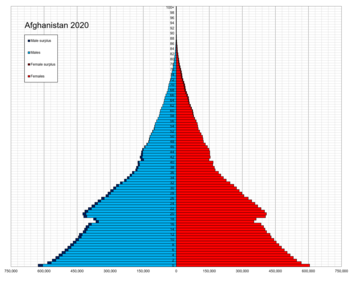
Back Əfqanıstan əhalisi Azerbaijani Насельніцтва Афганістана Byelorussian Население на Афганистан Bulgarian Obyvatelstvo Afghánistánu Czech Demografio de Afganio Esperanto Demografía de Afganistán Spanish جمعیتشناسی افغانستان Persian Démographie de l'Afghanistan French अफगानिस्तान की जनसांख्यिकी Hindi ავღანეთის დემოგრაფია Georgian
| Demographics of Afghanistan | |
|---|---|
 Afghanistan population pyramid in 2020 | |
| Population | 41,128,771 (2022) |
| Growth rate | 2.56% (2022) |
| Birth rate | 35.14/1000 (2022) |
| Death rate | 6.91/1000 (2022) |
| Life expectancy | 62.88 years at birth (2022) |
| Fertility rate | 4.52 children per woman (2022) |
| Infant mortality rate | 44.8/1000 (2022) |
| Nationality | |
| Nationality | Afghan |
| Major ethnic | Pashtuns |
| Minor ethnic | Tajiks, Hazara, Aimaks, Uzbeks, Turkmens, Baloch, Gujjars, Nuristanis, Pamiris, Arabs etc. |

The population of Afghanistan is around 41 million as of 2023.[1] The nation is composed of a multi-ethnic and multilingual society, reflecting its location astride historic trade and invasion routes between Central Asia, South Asia, and Western Asia. Ethnic groups in the country include Pashtun, Tajik, Hazara, Uzbek, as well as smaller groups such as Baloch, Nuristani, Turkmen, Aimaq, Mongol and some others which are less known.[2][3][4][5][6][7][8] Together they make up the contemporary Afghan people.
Approximately 46% of the population is under 15 years of age, and 74% of all Afghans live in rural areas.[9] The average woman gives birth to five children during her entire life, the highest fertility rate outside of Africa. About 6.8% of all babies die in child-birth or infancy.[9] The average life expectancy of the nation was reported in 2019 at around 63 years,[10][11] and only 0.04% of the population has HIV.[7]
Persian (Dari) and Pashto are the official languages of the country.[12] Dari functions as the inter-ethnic lingua franca for the vast majority. Pashto is widely used in the regions south of the Hindu Kush mountains and as far as the Indus River in neighbouring Pakistan. Uzbek and Turkmen are smaller languages spoken in parts of the north.[7] Multilingualism is common throughout the country, especially in the major cities.
Up to 89.7% of the population practices Sunni Islam and belongs to the Hanafi Islamic law school, while 10–15% are followers of Shia Islam;[7][13] the majority of whom belong to the Twelver branch, with smaller numbers of Ismailis. The remaining 0.3% practice other religions such as Sikhism and Hinduism. Excluding urban populations in the principal cities, most people are organised into tribal and other kinship-based groups, who follow their own traditional customs.
- ^ "Afghanistan Population (2021) - Worldometer".
- ^ Iwamura, Shinobu (April 1956). "Hunting for the Génghis Khanid Mongols in Afghanistan". Japan Quarterly. 3 (2): 213. ProQuest 1304280677.
- ^ "Mongolian".
- ^ "Mongolian".
- ^ "Mongolian languages summary | Britannica".
- ^ "Critics: New Categories on Afghan IDs Will Incite Ethnic Tension". TOLOnews. 17 March 2021. Retrieved 17 March 2021.
- ^ a b c d Cite error: The named reference
Factbookwas invoked but never defined (see the help page). - ^ Lieven, Anatol (21 April 2016). "What Chance for Afghanistan?". The New York Review of Books. Archived from the original on 22 April 2016.
- ^ a b "Afghanistan". UNESCO. 27 November 2016. Archived from the original on 10 May 2017.
- ^ "Afghanistan". World Health Organization (WHO). Retrieved 1 March 2021.
- ^ "Afghanistan". United Nations Development Programme (UNDP). 2020. Retrieved 1 March 2021.
- ^ Cite error: The named reference
Constitutionwas invoked but never defined (see the help page). - ^ Cite error: The named reference
Pewwas invoked but never defined (see the help page).
© MMXXIII Rich X Search. We shall prevail. All rights reserved. Rich X Search